网站的建设方案怎么写百度首页入口
Elasticsearch(一)
初始elasticsearch
什么是elasticsearch
elasticsearch是一款非常强大的开源搜索引擎,可以帮助我们从海量数据中快速查找到需要的内容
elasticsearch结合kibana、Logstash、Beats,也就是elastic stack(ELK)。被广泛应用在日志数据分析、实时监控等领域。
elasticsearch是elastic stack的核心,负责存储、搜索、分析数据
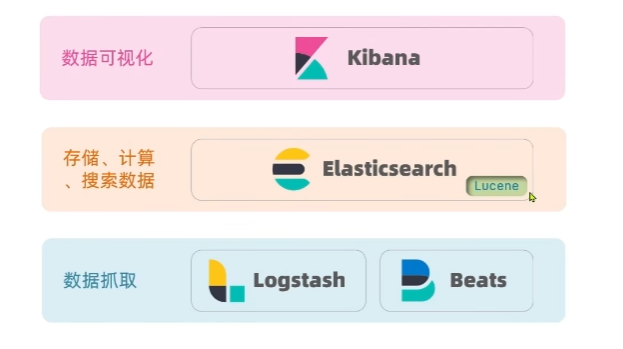
Lucene是一个Java语言的搜索引擎类库:https://lucene.apache.org/
优势:
- 易扩展
- 高性能(基于倒排索引)
缺点:
- 只限于Java语言开发
- 学习路线陡峭
- 不支持水平扩展
Elasticsearch:https://www.elastic.co/cn/
相比与lucene,elasticsearch具备下列优势:
- 支持分布式,可水平扩展
- 提供Restful接口,可被任何语言调用
搜索引擎技术排名:
- Elasticsearch:开源分布式搜索引擎
- Splunk:商业项目
- Solr:Apache的开源搜索引擎
正向索引和倒排索引
传统数据库采用正向索引,例如给下表中创建id索引:

elasticsearch采用倒排索引:
- 文档:每条数据就是一个文档
- 词条:文档按照语义分成词语
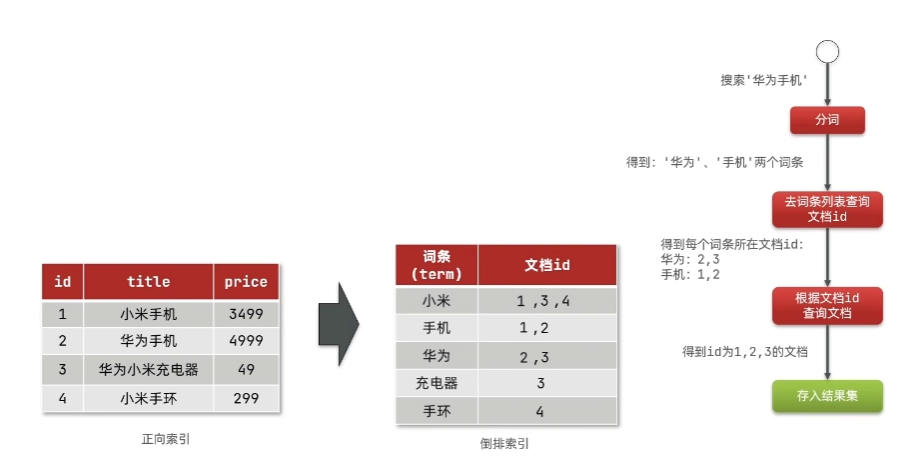
文档
elasticsearch是面向文档存储的,可以是数据库中的一条商品数据,一个订单信息
文档数据会被序列化为json格式后存储在elasticsearch中
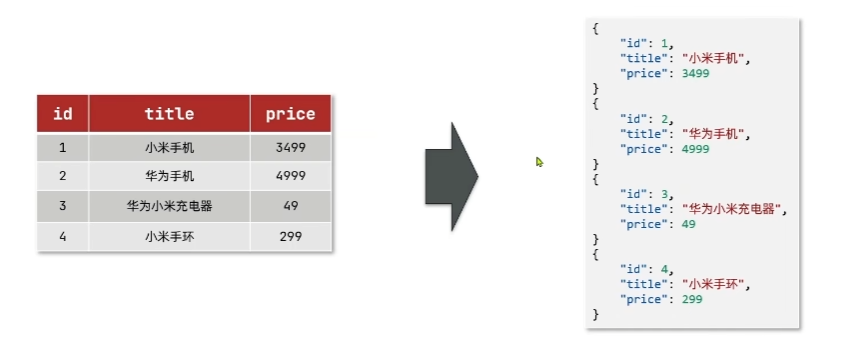
索引
索引:相同类型的文档的集合
映射:索引中文案的字段约束信息,类似于表的结构约束

概念对比

架构
Mysql:擅长事务类型操作,可以确保数据的安全和一致性
Elasticsearch:擅长海量数据的搜索、分析、计算
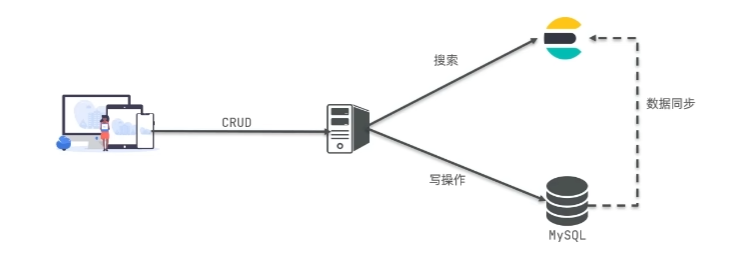
安装elasticsearch、kibana
1.部署单点es
1.1.创建网络
因为我们还需要部署kibana容器,因此需要让es和kibana容器互联。这里先创建一个网络:
docker network create es-net
1.2.加载镜像
这里我们采用elasticsearch的7.12.1版本的镜像,这个镜像体积非常大,接近1G。不建议大家自己pull。
课前资料提供了镜像的tar包:
大家将其上传到虚拟机中,然后运行命令加载即可:
# 导入数据
docker load -i es.tar
同理还有kibana的tar包也需要这样做。
1.3.运行
运行docker命令,部署单点es:
docker run -d \--name es \-e "ES_JAVA_OPTS=-Xms512m -Xmx512m" \-e "discovery.type=single-node" \-v es-data:/usr/share/elasticsearch/data \-v es-plugins:/usr/share/elasticsearch/plugins \--privileged \--network es-net \-p 9200:9200 \-p 9300:9300 \
elasticsearch:7.12.1
命令解释:
- -e “cluster.name=es-docker-cluster”:设置集群名称
- -e “http.host=0.0.0.0”:监听的地址,可以外网访问
- -e “ES_JAVA_OPTS=-Xms512m -Xmx512m”:内存大小
- -e “discovery.type=single-node”:非集群模式
- -v es-data:/usr/share/elasticsearch/data:挂载逻辑卷,绑定es的数据目录
- -v es-logs:/usr/share/elasticsearch/logs:挂载逻辑卷,绑定es的日志目录
- -v es-plugins:/usr/share/elasticsearch/plugins:挂载逻辑卷,绑定es的插件目录
- –privileged:授予逻辑卷访问权
- –network es-net :加入一个名为es-net的网络中
- -p 9200:9200:端口映射配置
在浏览器中输入:http://192.168.72.133:9200 即可看到elasticsearch的响应结果:
2.部署kibana
kibana可以给我们提供一个elasticsearch的可视化界面,便于我们学习。
2.1.部署
运行docker命令,部署kibana
docker run -d \
--name kibana \
-e ELASTICSEARCH_HOSTS=http://es:9200 \
--network=es-net \
-p 5601:5601 \
kibana:7.12.1
- –network es-net :加入一个名为es-net的网络中,与elasticsearch在同一个网络中
- -e ELASTICSEARCH_HOSTS=http://es:9200":设置elasticsearch的地址,因为kibana已经与elasticsearch在一个网络,因此可以用容器名直接访问elasticsearch
- -p 5601:5601:端口映射配置
kibana启动一般比较慢,需要多等待一会,可以通过命令:
docker logs -f kibana
查看运行日志,当查看到下面的日志,说明成功:
此时,在浏览器输入地址访问:http://192.168.72.133:5601,即可看到结果
2.2.DevTools
kibana中提供了一个DevTools界面:
这个界面中可以编写DSL来操作elasticsearch。并且对DSL语句有自动补全功能。
3.安装IK分词器
官网:https://github.com/medcl/elasticsearch-analysis-ik
3.1.在线安装ik插件(较慢)
# 进入容器内部
docker exec -it elasticsearch /bin/bash# 在线下载并安装
./bin/elasticsearch-plugin install https://github.com/medcl/elasticsearch-analysis-ik/releases/download/v7.12.1/elasticsearch-analysis-ik-7.12.1.zip#退出
exit
#重启容器
docker restart elasticsearch
3.2.离线安装ik插件(推荐)
1)查看数据卷目录
安装插件需要知道elasticsearch的plugins目录位置,而我们用了数据卷挂载,因此需要查看elasticsearch的数据卷目录,通过下面命令查看:
docker volume inspect es-plugins
显示结果:
[{"CreatedAt": "2022-05-06T10:06:34+08:00","Driver": "local","Labels": null,"Mountpoint": "/var/lib/docker/volumes/es-plugins/_data","Name": "es-plugins","Options": null,"Scope": "local"}
]
说明plugins目录被挂载到了:/var/lib/docker/volumes/es-plugins/_data这个目录中。
2)解压缩分词器安装包
下面我们需要把课前资料中的ik分词器解压缩,重命名为ik
3)上传到es容器的插件数据卷中
也就是/var/lib/docker/volumes/es-plugins/_data:
4)重启容器
# 4、重启容器
docker restart es
# 查看es日志
docker logs -f es
5)测试:
IK分词器包含两种模式:
- ik_smart:最少切分
- ik_max_word:最细切分
POST /_analyze
{"analyzer": "ik_max_word","text": "希诚是无敌的,xc is best"
}
结果:
{"tokens" : [{"token" : "希","start_offset" : 0,"end_offset" : 1,"type" : "CN_CHAR","position" : 0},{"token" : "诚","start_offset" : 1,"end_offset" : 2,"type" : "CN_CHAR","position" : 1},{"token" : "是","start_offset" : 2,"end_offset" : 3,"type" : "CN_CHAR","position" : 2},{"token" : "无敌","start_offset" : 3,"end_offset" : 5,"type" : "CN_WORD","position" : 3},{"token" : "的","start_offset" : 5,"end_offset" : 6,"type" : "CN_CHAR","position" : 4},{"token" : "xc","start_offset" : 7,"end_offset" : 9,"type" : "ENGLISH","position" : 5},{"token" : "best","start_offset" : 13,"end_offset" : 17,"type" : "ENGLISH","position" : 6}]
}
3.3 扩展词词典
随着互联网的发展,“造词运动”也越发的频繁。出现了很多新的词语,在原有的词汇列表中并不存在。比如:“奥力给”,“泰库辣” 等。
所以我们的词汇也需要不断的更新,IK分词器提供了扩展词汇的功能。
1)打开IK分词器config目录:
2)在IKAnalyzer.cfg.xml配置文件内容添加:
<?xml version="1.0" encoding="UTF-8"?>
<!DOCTYPE properties SYSTEM "http://java.sun.com/dtd/properties.dtd">
<properties><comment>IK Analyzer 扩展配置</comment><!--用户可以在这里配置自己的扩展字典 *** 添加扩展词典--><entry key="ext_dict">ext.dic</entry>
</properties>
3)新建一个 ext.dic,可以参考config目录下复制一个配置文件进行修改
泰库辣
奥力给
4)重启elasticsearch
docker restart es# 查看 日志
docker logs -f elasticsearch
日志中已经成功加载ext.dic配置文件
5)测试效果:
GET /_analyze
{"analyzer": "ik_max_word","text": "如果你也跟我一样的话,那么我觉得,泰库辣"
}
注意当前文件的编码必须是 UTF-8 格式,严禁使用Windows记事本编辑
3.4 停用词词典
在互联网项目中,在网络间传输的速度很快,所以很多语言是不允许在网络上传递的,如:关于宗教、政治等敏感词语,那么我们在搜索时也应该忽略当前词汇。
IK分词器也提供了强大的停用词功能,让我们在索引时就直接忽略当前的停用词汇表中的内容。
1)IKAnalyzer.cfg.xml配置文件内容添加:
<?xml version="1.0" encoding="UTF-8"?>
<!DOCTYPE properties SYSTEM "http://java.sun.com/dtd/properties.dtd">
<properties><comment>IK Analyzer 扩展配置</comment><!--用户可以在这里配置自己的扩展字典--><entry key="ext_dict">ext.dic</entry><!--用户可以在这里配置自己的扩展停止词字典 *** 添加停用词词典--><entry key="ext_stopwords">stopword.dic</entry>
</properties>
3)在 stopword.dic 添加停用词
习大大
4)重启elasticsearch
# 重启服务
docker restart elasticsearch
docker restart kibana# 查看 日志
docker logs -f elasticsearch
日志中已经成功加载stopword.dic配置文件
5)测试效果:
GET /_analyze
{"analyzer": "ik_max_word","text": "如果你也跟我一样的话,那么我觉得,泰库辣,xxx!"
}
注意当前文件的编码必须是 UTF-8 格式,严禁使用Windows记事本编辑
索引库操作
mapping属性
mapping是对索引库中文档的约束,常见的mapping属性包括:https://www.elastic.co/guide/en/elasticsearch/reference/current/mapping.html
-
type:字段数据类型,常见的简单类型有:
-
- 字符串:text(可分词的文本)、keyword(精确值,例如:品牌、国家、ip地址)
- 数值:long、integer、short、byte、double、float
- 布尔:boolean
- 日期:date
- 对象:object
-
index:是否创建索引,默认为true
-
analyzer:使用哪种分词器
-
properties:该字段的子字段
创建索引库
ES通过Restful请求操作索引库、文档。请求内容用DSL语句来表示。创建索引库和mapping的DSL语法如下:

# 创建索引库
PUT /xc
{"mappings": {"properties": {"info":{"type": "text","analyzer": "ik_smart"},"email":{"type": "keyword","index": false },"name":{"type": "object","properties": {"firstName":{"type": "keyword"},"lastName":{"type": "keyword"}}}}}
}
查看、删除索引库
查看索引库语法:
GET /索引库名称
删除索引库的语法
DELETE /索引库名称
修改索引库
索引库和mapping一旦创建无法修改,但是可以添加新的字段,语法:
PUT /索引库名/_mapping
{"properties": {"新字段名":{"type": "text"}}
}
文档操作
添加文档
新增文档的DSL语法:
POST /索引库名/_doc/文档id
{"字段1": "值1","字段2": "值2","字段3": {"子属性1": "值3","子属性2": "值4"}
}
查询、删除文档
查询
GET /索引库名/_doc/文档id
删除
DELETE /索引库名/_doc/文档id
修改文档
方式一:全量修改,会删除旧文档,添加新文档
PUT /索引库名/_doc/文档id
{"字段1": "值1","字段2": "值2","字段3": {"子属性1": "值3","子属性2": "值4"}
}
方式二:增量修改,修改指定字段值
POST /索引库名/_update/文档id
{"doc":{"字段值":"新的值"}
}
RestAPI
ES官网提供了各种不同语言的客户端,用来操作ES。这些客户端的本质就是组装DSL语句,通过http请求发送给ES。官网:https://www.elastic.co/guide/en/elasticsearch/client/index.html
案例:利用JavaRestClient实现创建、删除索引库,判断索引库是否存在
1. 分析数据结构,定义mapping属性
小提示:

定义mapping属性
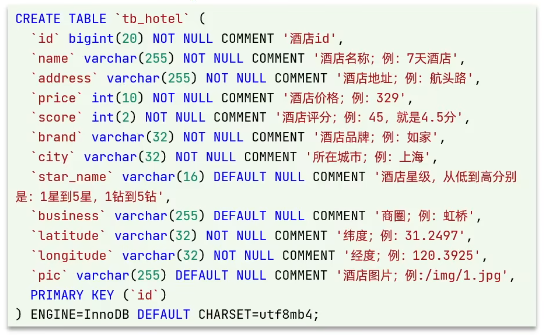
PUT /hotel
{"mappings": {"properties": {"id":{"type": "keyword"},"name":{"type": "text","analyzer": "ik_max_word","copy_to": "all"},"address":{"type": "keyword","index": false},"price":{"type": "integer"},"score":{"type":"integer"},"brand":{"type": "keyword","copy_to": "all"},"city":{"type": "keyword"},"starName":{"type": "keyword"},"business":{"type": "keyword","copy_to": "all"},"location":{"type": "geo_point"},"pic":{"type": "keyword","index": false},"all":{"type": "text","analyzer": "ik_max_word"}}}
}
2. 初始化JavaRestClient
导入依赖
<dependency><groupId>org.elasticsearch.client</groupId><artifactId>elasticsearch-rest-high-level-client</artifactId><version>7.12.1</version></dependency>
将springboot管理的es依赖7.6.x的替换成直接管理的
<properties><elasticsearch.version>7.12.1</elasticsearch.version></properties>
初始化RestHignLevelClient
package cn.itcast.hotel;import org.apache.http.HttpHost;
import org.elasticsearch.client.RestClient;
import org.elasticsearch.client.RestHighLevelClient;
import org.junit.jupiter.api.AfterEach;
import org.junit.jupiter.api.BeforeEach;
import org.junit.jupiter.api.Test;
import org.springframework.boot.test.context.SpringBootTest;import java.io.IOException;/*** @author xc* @date 2023/5/10 18:38*/
@SpringBootTest
public class HotelIndexTest {private RestHighLevelClient client;@Testvoid testInit(){System.out.println(client);}// 在调用方法后执行的操作@BeforeEachvoid setUp() {this.client = new RestHighLevelClient(RestClient.builder(HttpHost.create("http://192.168.72.133:9200")));}// 在调用方法前执行的操作@AfterEachvoid tearDown() throws IOException {this.client.close();}
}
3. 创建索引库
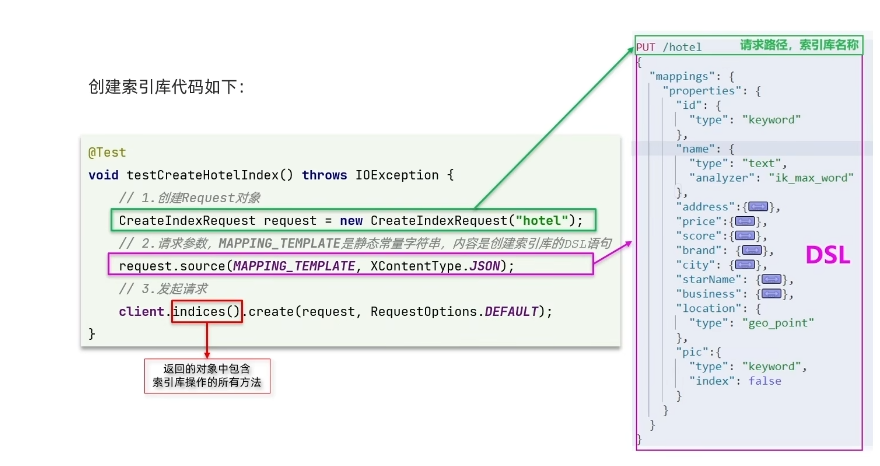
创建索引库
@Testvoid testInit() throws IOException {// 1.创建Request对象CreateIndexRequest request = new CreateIndexRequest("hotel");// 2.准备请求参数:DSL语句request.source(MAPPING_TEMPLATE, XContentType.JSON);// 3.发送请求client.indices().create(request, RequestOptions.DEFAULT);}
4. 删除索引库、判断索引库是否存在
- 删除索引库代码
@Testvoid testDeleteHotelIndex() throws IOException {// 1.创建Request对象DeleteIndexRequest request = new DeleteIndexRequest("hotel");// 2.发送请求client.indices().delete(request,RequestOptions.DEFAULT);}
- 判断索引库是否存在
@Testvoid testExistsHotelIndex() throws IOException {// 1.创建Request对象GetIndexRequest request = new GetIndexRequest("hotel");// 2.发送请求boolean exists = client.indices().exists(request, RequestOptions.DEFAULT);System.out.println(exists);}
案例:利用JavaRestClient实现文档的CRUD
1.利用JavaRestClient新增酒店数据
@Testvoid testAddDocument() throws IOException {List<Hotel> hotel = hotelService.list();hotel.forEach(h -> {HotelDoc hotelDoc = new HotelDoc(h);IndexRequest request = new IndexRequest("hotel").id(h.getId().toString());request.source(JSON.toJSONString(hotelDoc),XContentType.JSON);try {client.index(request,RequestOptions.DEFAULT);} catch (IOException e) {throw new RuntimeException(e);}});}
2.利用JavaRestClient根据id查询酒店数据
@Testvoid testGETDocument() throws IOException {GetRequest request = new GetRequest("hotel","61083");GetResponse documentFields = client.get(request, RequestOptions.DEFAULT);String json = documentFields.getSourceAsString();System.out.println(json);}
3.利用JavaRestClient删除酒店数据
@Testvoid testDELETEDocument() throws IOException {DeleteRequest request = new DeleteRequest("hotel","61083");client.delete(request, RequestOptions.DEFAULT);}
4.利用JavaRestClient修改酒店数据
@Testvoid testUpdateDocument() throws IOException {UpdateRequest request = new UpdateRequest("hotel", "61083");request.doc("city","武汉");client.update(request, RequestOptions.DEFAULT);}
案例:批量导入数据
@Testvoid testBulkRequest() throws IOException {BulkRequest request = new BulkRequest();List<Hotel> hotel = hotelService.list();hotel.forEach(h -> {HotelDoc hotelDoc = new HotelDoc(h);request.add(new IndexRequest("hotel").id(hotelDoc.getId().toString()).source(JSON.toJSONString(hotelDoc),XContentType.JSON));});client.bulk(request,RequestOptions.DEFAULT);}
EFAULT);}
4.利用JavaRestClient修改酒店数据
@Testvoid testUpdateDocument() throws IOException {UpdateRequest request = new UpdateRequest("hotel", "61083");request.doc("city","武汉");client.update(request, RequestOptions.DEFAULT);}
案例:批量导入数据
@Testvoid testBulkRequest() throws IOException {BulkRequest request = new BulkRequest();List<Hotel> hotel = hotelService.list();hotel.forEach(h -> {HotelDoc hotelDoc = new HotelDoc(h);request.add(new IndexRequest("hotel").id(hotelDoc.getId().toString()).source(JSON.toJSONString(hotelDoc),XContentType.JSON));});client.bulk(request,RequestOptions.DEFAULT);}
